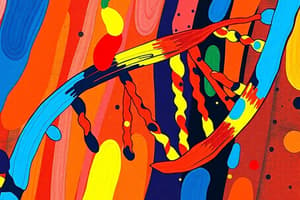Podcast
Questions and Answers
What is the main distinction between purines and pyrimidines?
What is the main distinction between purines and pyrimidines?
- Purines have two ring structures, while pyrimidines have one. (correct)
- Purines have one ring structure, while pyrimidines have two.
- Purines pair exclusively with purines, while pyrimidines pair exclusively with pyrimidines.
- Purines are larger than pyrimidines, which are smaller.
According to Chargaff’s Rule, which statement is true?
According to Chargaff’s Rule, which statement is true?
- The total number of cytosine and thymine is equal to the total number of adenine and guanine.
- The amount of adenine is equal to the amount of thymine. (correct)
- The total number of purines is greater than the number of pyrimidines.
- The amount of cytosine is equal to the amount of adenine.
Which component is unique to RNA compared to DNA?
Which component is unique to RNA compared to DNA?
- Deoxyribose as a sugar
- Double-stranded structure
- Thymine as a nitrogenous base
- Uracil as a nitrogenous base (correct)
What defines a homozygous recessive genotype?
What defines a homozygous recessive genotype?
What is the primary function of RNA in the cell?
What is the primary function of RNA in the cell?
What is the primary purpose of selective breeding?
What is the primary purpose of selective breeding?
Which of the following is a risk associated with selective breeding?
Which of the following is a risk associated with selective breeding?
What term describes the offspring that arise from crossing individuals with unlike characteristics?
What term describes the offspring that arise from crossing individuals with unlike characteristics?
Who is considered the Father of Genetics?
Who is considered the Father of Genetics?
What does hybrid vigor refer to?
What does hybrid vigor refer to?
Which of the following is NOT a step in selective breeding?
Which of the following is NOT a step in selective breeding?
What is the main economic importance of selective breeding in animals?
What is the main economic importance of selective breeding in animals?
What is the initial step in the hybridization process?
What is the initial step in the hybridization process?
Why might royal families select members with similar traits?
Why might royal families select members with similar traits?
What is one of Gregor Mendel's laws that relates to genetics?
What is one of Gregor Mendel's laws that relates to genetics?
Flashcards are hidden until you start studying
Study Notes
Nucleotides and Nucleic Acids
- Nucleotides are the building blocks of nucleic acids: DNA and RNA.
- Composed of a phosphate group, sugar, and nitrogenous base.
- DNA contains deoxyribose sugar; RNA contains ribose sugar.
Base Pairing in DNA and RNA
- DNA pairs: Cytosine ↔ Guanine, Adenine ↔ Thymine.
- RNA pairs: Cytosine ↔ Guanine, Adenine ↔ Uracil.
- Purines (2 rings) and pyrimidines (1 ring) must pair consistently to maintain width.
Chargaff’s Rule
- Amount of Cytosine equals Guanine and amount of Thymine equals Adenine.
- Total purines equal total pyrimidines, maintaining the structure of DNA.
Functions of DNA and RNA
- DNA is the blueprint of life, storing genetic information.
- RNA synthesizes proteins using DNA as a template, enabling translation.
Genetic Engineering and Classical Breeding
- Classical breeding involves mating organisms with desirable traits, either naturally or controlled.
- Genetic engineering is the manipulation of an organism's genes, resulting in genetically modified organisms (GMOs).
Genotype and Phenotype
- Genotype refers to an organism's complete set of heritable genes, including homozygous dominant (AA), heterozygous (Aa), and homozygous recessive (aa).
- Phenotype refers to observable traits influenced by the environment (phenocopy).
Gregor Mendel and Genetic Laws
- Considered the father of genetics, famous for his work with pea plants.
- Formulated three fundamental laws: dominance and uniformity, segregation, and independent assortment.
Selective Breeding
- Involves choosing parent organisms with desirable traits to produce offspring.
- Steps include identifying important traits, selecting parents, and continuously breeding the best offspring.
Economic Importance of Selective Breeding
- Selective breeding improves traits in animals (e.g., Angus cattle for muscle mass) and plants (e.g., insect-resistant crops).
Benefits and Risks of Selective Breeding
- Benefits: Increased food quality and yield; selection of harmless traits (e.g., polled cattle).
- Risks: Diseases may spread easily due to decreased genetic variation, and recessive genetic diseases may become more prevalent.
Hybridization
- Combines two genetically distinct individuals to create offspring with desirable characteristics.
- Often results in hybrid vigor, where offspring exhibit superior traits compared to parents.
Notable Figures
- Luther Burbank: Noted American botanist known for creating disease-resistant and high-yield crops, such as Burbank potatoes.
Studying That Suits You
Use AI to generate personalized quizzes and flashcards to suit your learning preferences.



